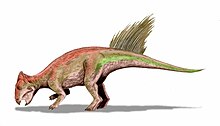Liaoceratops
|
Liaoceratops Temporal range: Early Cretaceous, 130 Ma |
|
|---|---|
 |
|
| Scientific classification | |
| Kingdom: | Animalia |
| Phylum: | Chordata |
| Class: | Reptilia |
| Superorder: | Dinosauria |
| Order: | Ornithischia |
| Suborder: | Cerapoda |
| Infraorder: | Ceratopsia |
| Genus: | Liaoceratops |
| Species: | L. yanzigouensis |
| Binomial name | |
|
Liaoceratops yanzigouensis Xu, 2002 |
|
Liaoceratops, meaning "Liao Horned Face", is a ceratopsian dinosaur believed to be an early relative of the horned ceratopsids. It lived in the early Cretaceous, some 130 million years ago. It was discovered in China by a team of American and Chinese scientists. Liaoceratops was much smaller than its later relatives, but offers a glimpse into the early evolution of this group of dinosaurs.
Liaoceratops was discovered in the famous Liaoning Province of China, where several fossils of feathered dinosaurs have also been collected. The type species Liaoceratops yanzigouensis was in 2002 named and described by Xu Xing, Peter Makovicky, Wang Xiaolin, Mark Norell and You Hailu. The generic name is derived from Liaoning and the Greek keras, "horn" and ops, "face". The specific name refers to the town Yanzigou.
The holotype IVPP V12738 has been found in the Yixian Formation dating from the Barremian. These beds have also yielded fossil insects, fossils of ginkgo trees, and many other dinosaurs, including the early troodontid Sinovenator, also described by Makovicky later in 2005.
"This area is yielding extremely important information on the evolution of dinosaurs, mammals, insects, and flowering plants. I hope to find even more primitive specimens than Liaoceratops," Peter Makovicky said.
...
Wikipedia
